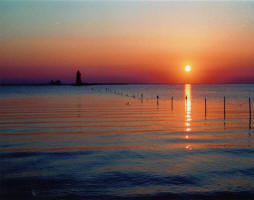 Impact of sea level rise on groundwater flow regimes: A sensitivity analysis for the Netherlands
Impact of sea level rise on groundwater flow regimes: A sensitivity analysis for the Netherlands
In this thesis (1996), G.H.P. Oude Essink investigates the possible impact of sea-level rise and human activities on vulnerable coastal groundwater flow regimes in the Netherlands for the next millennium. The focus is on the distribution of fresh and saline groundwater, the volumes of freshwater lenses in the dunes and the seepage and salt load to polders. Since groundwater flow is a slow process, the consequences for the next thousand years are considered.
A 2-D model simulating density-dependent groundwater flow and coupled solute transport model is used. The main result is that a severe (irreversible) salinisation process, which is generated by human activities such as the reclamation of the (low-lying) polders during the past centuries, already occurs in the groundwater flow regimes along the Dutch coast, independent of sea-level rise. It is to be expected that sea-level rise intensifies this salinisation process. Feasible countermeasures may, to some extent, retard (but not stop) this salinisation process. The impact of sea-level rise is also discussed in indicative terms for three water management sectors: (1) domestic and industrial water supply from coastal sand-dunes, (2) flushing of water courses of low-lying polders and (3) agriculture in terms of salt damage.
Impact of sea level rise on groundwater flow regimes: A sensitivity analysis for the Netherlands
| Contact information | n/a |
|---|---|
| News type | Inbrief |
| File link |
http://www.hydrology.nl/images/docs/dutch/1996.05.07_Oude_Essink.pdf |
| Source of information | Hydrology.nl |
| Keyword(s) | groundwater flow regime, sea level |
| Subject(s) | HYDRAULICS - HYDROLOGY , INFORMATION - COMPUTER SCIENCES , METHTODOLOGY - STATISTICS - DECISION AID , NATURAL MEDIUM , RISKS AND CLIMATOLOGY |
| Relation | http://www.emwis.net/topics/groundwater |
| Geographical coverage | Netherlands, |
| News date | 15/02/2013 |
| Working language(s) | ENGLISH |
 you are not logged in
you are not logged in





